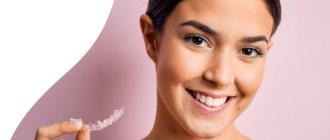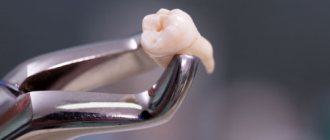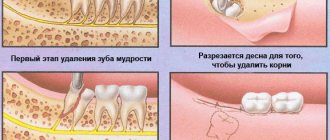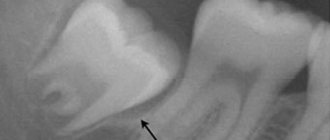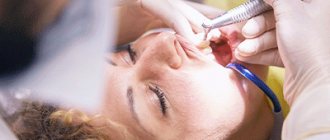01.12.2019
My child’s teeth have started to grow crooked, what should I do? How to solve the problem with milk and permanent curved row. Modern corrective orthodontic systems.
If a child’s tooth grows crookedly, then this is not only a cosmetic problem. A malocclusion can affect the health of the oral cavity and the digestive system. Bite correction must begin at an early age. At the same time, baby and permanent teeth need to be treated for curvature.
A child’s first teeth – and already crooked? Why
When a baby’s first teeth are crooked, parents don’t know what to do, whether it’s dangerous or not. Only a pediatric dentist can answer this question. After the examination, he will advise what measures need to be taken. In any case, you should not panic; it is recommended to pay attention to the following factors:
- if there are even spaces between the teeth, then it is possible to naturally correct the position of the growing units
- unequal gaps indicate shifts in tooth spacing and can lead to deformation of the permanent row
- Do not hope that after crooked baby teeth fall out, the permanent ones will be straight, this may not happen
The reasons for the formation of curvature of the first teeth are the lack of solid food, training of the chewing reflex, diseases of the nasopharynx, heredity, and incorrect anatomy of the frenulum.
Attention! Feeding from a bottle with a soft nipple often causes curvature of the milk line, which then affects the permanent one.
Are your new teeth growing crooked? A few words about braces
If, after falling out, new teeth grow crookedly, then the cause may be late loss of milk teeth. In addition, the uneven eruption of the molar units plays a role, and also that the jaw in its formation lags behind the eruption of large elements. In this case, new teeth can grow not only crooked, but also in two rows. If the curvature is temporary, then the appearance of a double row requires the intervention of an orthodontist. Currently, there is an effective system for correcting malocclusion and curvature - braces. They are attached to the enamel coating and work according to a tension system of various structural elements. This alignment of the teeth is a long process and inconvenient for the baby, since braces cannot be removed during the treatment period. There are two types of braces - those attached to the outside of the row and to the inside. The first are called vestibular, the second - lingual. But the latter complicate the chewing process, so they are rarely used for children.
Signs of malocclusion in children
Noticeable external symptoms:
- Incorrectly positioned, tilted or turned teeth;
- Large gaps between teeth or crowding;
- Disproportional jaws: too protruding in relation to each other or underdeveloped.
Indirect signals:
- The child bites his cheeks or tongue;
- Complains of pain in the jaw and facial muscles;
- Breathes mainly through the mouth;
- He has difficulty swallowing or chewing food;
- New teeth erupt with a delay.
Children's open bite
If you suspect a deviation from the norm, you should visit an orthodontist without self-treatment. Even in the absence of symptoms of malocclusion, a preventative consultation with a doctor is recommended after 2-3 years in order to identify problems as early as possible.
Is it possible to completely correct crooked teeth?
Having discovered a problem, parents wonder whether it is possible to correct crooked teeth and how to do this so that the baby does not experience discomfort. Alignment is easier for children than for adults.
- Gum tissues are pliable and perfectly susceptible to orthopedic influences.
- Dental units are plastic, so they easily fall into place
- Children's bites can be corrected without the use of radical methods.
Keep in mind! Complete correction of the dentition in childhood is possible; this must be done before the age of 8 years. Timely correction will help avoid orthodontic problems in the future.
Let's sum it up
The issue of malocclusion should be resolved in infancy (using pacifiers) or primary school age, that is, as early as possible. Otherwise, serious physical and mental consequences are possible. Before developing therapeutic tactics, professional doctors first determine why children grow very crooked teeth (photos of uneven jaws and corrected versions can be seen below). In case of sufficiently serious anomalies of the maxillofacial apparatus that worsen the quality of life of a small person, surgical intervention is indicated. In other situations, you can get by with less radical methods (plates, trainers, braces), the choice of which depends on the patient’s age, his personal preferences and the financial capabilities of the parents
What to do if your child’s teeth begin to grow crookedly
When a child has crooked teeth, parents will learn from a doctor’s consultation what to do and how not to be late with straightening. The step-by-step actions look like this:
- monitor your baby’s oral cavity and pay attention to how the baby teeth change position
- pays attention to nutrition, introduce calcium, vitamins, microelements into the diet
- start feeding solid foods on time from 8 months of age
- treat chronic diseases of the nasopharynx, eliminate problems when the baby breathes through the mouth
- make efforts to eliminate the habit of sucking a pacifier, finger, constantly sleeping with a bottle
By eliminating the causes and being vigilant and not postponing a visit to the pediatric dentist, you can solve the problem in a timely manner.
Causes of malocclusion in children
The bite is formed in the womb and is often determined by heredity
or
the mother's nutrition
during pregnancy. The active occurrence of deviations occurs immediately after birth. Their causes, in addition to genetics, include eating habits, sleeping positions, habits and illnesses:
- Artificial feeding.
Children are born with different jaw sizes: the lower one is slightly shortened. Up to a year, the jaws are leveled due to the active work of the muscles and jaws during breastfeeding. When sucking a bottle, the lower jaw almost does not strain and does not develop, lagging behind the upper jaw.
- Breastfeeding after 1.5 years.
After this age, solid foods must be introduced into the child's diet. Due to active work during chewing, muscles, jaws and teeth develop and grow correctly. - Frequent sucking of pacifiers, fingers, pencils.
The constant presence of objects in the mouth prevents teeth from growing correctly and causes an open bite - a complete lack of contact in part of the dentition.
Formation of malocclusion
- Incorrect sleeping and feeding positions.
Throwing back the head, lowering the chin to the chest, hand under the cheek during sleep; - Diseases of the otolaryngological organs.
Natural human breathing occurs through the nose. If, due to a chronic runny nose, deviated septum, or adenoids, the child breathes mainly through the mouth, then the bite is formed incorrectly.
Fighting crooked baby teeth in a child
A child's crooked baby teeth can straighten naturally. In infants, bone jaw structures are formed, gum tissue grows, and teeth erupt. These processes are accompanied by some deformations, which dentists consider to be transient. That is, as all the units in the row appear, each of them finds its place, grinds in and is leveled. But if uneven gaps appear between the teeth, noticeable even to you, then urgent measures need to be taken. This sign is evidence of asymmetry in the development of the jaws. The consequences of curvature of the mammary row are unpleasant for the baby:
- a crooked tooth causes injury to the oral cavity, causing stomatitis
- poor chewing of food, affecting the functioning of the gastrointestinal tract
- there is pain in the jaw joint
- Difficulties in brushing contribute to the formation of oral infections and caries
That is, you need to fight the problem, but to do this you need to use the methods recommended by the doctor. For example, an effective system for correcting primary teeth is the use of soft vestibular plates that guide the growth of units and eliminate the defect at a very early stage.
Extraction (removal) of wisdom teeth
Horizontal growth of the extreme molar is a situation where the only correct solution is often its removal. The intervention of a dental surgeon helps to avoid serious consequences caused by abnormal dental growth. The extraction itself goes like this:
- Anesthesia. Having determined the position of the tooth, the doctor selects the appropriate anesthesia: local in mild cases or general anesthesia if serious surgical intervention is necessary.
- Antiseptic treatment. The surgical field is prepared - the gums and teeth are treated with an antiseptic solution that will destroy all bacteria and microbes living in the oral cavity.
- Gum cutting. Using surgical instruments, a flap of soft tissue is carefully cut and peeled off from the neck of the tooth, root and bone. After the operation, the gum is returned to its place and fixed with sutures.
- Molar extraction. Using forceps and an elevator (a specially shaped wedge), the tooth is loosened and removed from the socket. If a piece of the root breaks off during removal, then an excavator (special medical hook) is used.
- Processing the hole. After removing the molar, the doctor examines the resulting hole and treats it with special drugs that prevent infection.
- Stitching. The cut gum is held together using medical materials, which after some time dissolve on their own, leaving behind fused soft tissue.
How to correct crooked permanent teeth in a child
When children have crooked permanent teeth, the problem becomes much more complicated. The new units that have grown to replace dairy ones are larger. They need more space, the jaw develops more slowly, so the tooth becomes crooked and remains that way in the formed row. Permanent units have more powerful roots and are difficult to force to change position.
Correcting curvature with braces should begin in middle school. You will have to wear them for about 20 months. By adolescence, the dentition will already become normal, the child will not be embarrassed. It is advisable to use transparent lingual braces. They are attached to the inside and are invisible to other people.
How can you straighten your child's teeth without using braces?
Modern dentists know how to correct crooked teeth without braces. To do this, there are techniques and systems that do not need to be worn constantly.
- The use of plates that are removable devices. They guide the position of the tooth individually and the row as a whole. Made from casts
- Trainers help adjust units to the correct position. They can be removed and are made of flexible material that is not felt on the jaw
- Myotherapy is a special set of exercises for training the jaw apparatus and surrounding muscles
The doctor will decide which of these methods is suitable in your case, taking into account all the circumstances and features of the development of the defect.
Category Children Published by Mister stomatolog
Conclusions. Expert advice
Crooked teeth can appear for various reasons, ranging from heredity to bad habits. Both primary and permanent elements of the dentition grow incorrectly, and the “eights” of wisdom are almost always not formed correctly enough. Tooth curvature is not only a childhood disease. Trauma, age-related changes, or even a love of chewing pencils can cause problem teeth in adults.
It doesn’t matter whether you have one or several crooked incisors, you definitely need treatment. The first thing you need to do is contact a therapist, and then an orthodontist, who will decide what to do with crooked teeth in your situation. There are quite a few treatment methods, each with its own pros and cons. Sometimes the doctor decides to combine several methods, for example, installing braces and prescribing wearing a trainer. In especially severe cases, surgery is used.
Lack of treatment is very dangerous, because when teeth are crooked, the load during chewing is distributed unevenly. The longer the patient waits, the more severely some elements of the dentition wear out, leaving others without work. This leads to premature loss of molars and incisors. This is followed by bone depletion and expensive implant surgery, if it is possible at all. Avoiding such a development of events is not so difficult: you need to visit the orthodontist in time and correct the bite.

